World Roundup
January/February 2014


-
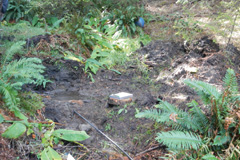 CALIFORNIA: Southern exposure, warm weather, and access to water made for a great site to establish a village in Humboldt County 1,000 years ago. Unfortunately, they are also the attributes of successful marijuana farms today—last year, the county sheriff’s office found more than 4,000. One, near Bridgeville, disrupted a Native American site that could be more than a millennium old, and the same may be the case with other farms. Officers are looking to tribes and archaeologists to learn what they should keep an eye out for on future busts. —Samir S. Patel
CALIFORNIA: Southern exposure, warm weather, and access to water made for a great site to establish a village in Humboldt County 1,000 years ago. Unfortunately, they are also the attributes of successful marijuana farms today—last year, the county sheriff’s office found more than 4,000. One, near Bridgeville, disrupted a Native American site that could be more than a millennium old, and the same may be the case with other farms. Officers are looking to tribes and archaeologists to learn what they should keep an eye out for on future busts. —Samir S. Patel -
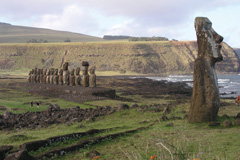 CHILE: To many, island cuisine means seafood—but not for Rapa Nui (Easter Island). According to a new study of isotopes in teeth excavated there, early people there never made significant use of the fish, shellfish, and marine mammals. Rather, their diet consisted heavily of rats, chickens, and plants such as tubers and bananas. In fact, the rats that are thought to have contributed to the island’s deforestation may have been brought by settlers as a source of food. —Samir S. Patel
CHILE: To many, island cuisine means seafood—but not for Rapa Nui (Easter Island). According to a new study of isotopes in teeth excavated there, early people there never made significant use of the fish, shellfish, and marine mammals. Rather, their diet consisted heavily of rats, chickens, and plants such as tubers and bananas. In fact, the rats that are thought to have contributed to the island’s deforestation may have been brought by settlers as a source of food. —Samir S. Patel -
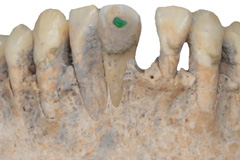 MEXICO: At the site of Uxul, excavators have uncovered the remains of 24 war captives dismembered 1,400 years ago. The remains had been placed in an artificial well and then sealed up, resulting in excellent preservation. They were not buried with offerings, though jade ornaments embedded in the teeth of five of them suggest they were of high status, perhaps soldiers or nobles from local kingdoms. Only part of the well has been excavated—many more bodies may still be found. —Samir S. Patel
MEXICO: At the site of Uxul, excavators have uncovered the remains of 24 war captives dismembered 1,400 years ago. The remains had been placed in an artificial well and then sealed up, resulting in excellent preservation. They were not buried with offerings, though jade ornaments embedded in the teeth of five of them suggest they were of high status, perhaps soldiers or nobles from local kingdoms. Only part of the well has been excavated—many more bodies may still be found. —Samir S. Patel -
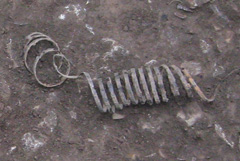 KENTUCKY: Elijah Pepper, his son Oscar, and James Crow are credited by historians with perfecting Kentucky bourbon in the 19th century. Bourbon is still made in some of their buildings today, and archaeologists are excavating some of the others, including what might have been a kitchen and slave quarters. Among the finds are toys such as marbles and doll parts, kitchen and dining ware, and a copper condensing coil and metal gauge used in the distillation process. —Samir S. Patel
KENTUCKY: Elijah Pepper, his son Oscar, and James Crow are credited by historians with perfecting Kentucky bourbon in the 19th century. Bourbon is still made in some of their buildings today, and archaeologists are excavating some of the others, including what might have been a kitchen and slave quarters. Among the finds are toys such as marbles and doll parts, kitchen and dining ware, and a copper condensing coil and metal gauge used in the distillation process. —Samir S. Patel -
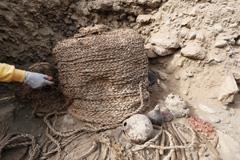 PERU: At the ceremonial complex of Huaca Pucllana in the heart of Lima, archaeologists have discovered an intact tomb containing two mummy bundles wrapped inside tightly coiled lantana-leaf rope. After decades of excavation, more than 65 burials have been found at the site, but only a handful were undisturbed. The mummies, an adult and a child, belong to the Wari culture that dominated the area between A.D. 450 and 1000. Archaeologists believe the child was sacrificed as a ritual offering. —Samir S. Patel
PERU: At the ceremonial complex of Huaca Pucllana in the heart of Lima, archaeologists have discovered an intact tomb containing two mummy bundles wrapped inside tightly coiled lantana-leaf rope. After decades of excavation, more than 65 burials have been found at the site, but only a handful were undisturbed. The mummies, an adult and a child, belong to the Wari culture that dominated the area between A.D. 450 and 1000. Archaeologists believe the child was sacrificed as a ritual offering. —Samir S. Patel -
 ENGLAND: Frogs’ legs have long been associated with the French, but new excavations at the Mesolithic site of Blick Mead, near Stonehenge, show that the English partook of the amphibian delicacy long before there was such a thing as French cuisine. A burned toad’s or frog’s leg—found among bones of eel, salmon, trout, aurochs, boar, and deer—is the oldest known evidence of a cooked frog’s leg, dating to between 8,000 and 10,000 years ago. —Samir S. Patel
ENGLAND: Frogs’ legs have long been associated with the French, but new excavations at the Mesolithic site of Blick Mead, near Stonehenge, show that the English partook of the amphibian delicacy long before there was such a thing as French cuisine. A burned toad’s or frog’s leg—found among bones of eel, salmon, trout, aurochs, boar, and deer—is the oldest known evidence of a cooked frog’s leg, dating to between 8,000 and 10,000 years ago. —Samir S. Patel -
 GERMANY: Fragments of rusted chain mail are providing insight into a great battle between Roman and Germanic forces in the 3rd century. The pieces of armor, which were uncovered near the edge of the site of the Battle at the Harzhorn, would have been worn by a Roman soldier. Scientists speculate that fellow soldiers may have removed the mail to tend to a fallen warrior’s wounds, or that Germanic warriors left the armor to commemorate an event during the pitched battle. —Samir S. Patel
GERMANY: Fragments of rusted chain mail are providing insight into a great battle between Roman and Germanic forces in the 3rd century. The pieces of armor, which were uncovered near the edge of the site of the Battle at the Harzhorn, would have been worn by a Roman soldier. Scientists speculate that fellow soldiers may have removed the mail to tend to a fallen warrior’s wounds, or that Germanic warriors left the armor to commemorate an event during the pitched battle. —Samir S. Patel -
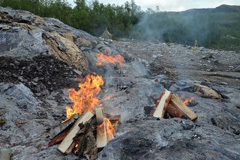 NORWAY: It can be hard to mine stone for making tools when your mining implements are also made of stone. At the Melsvik chert quarry, early Mesolithic people likely used a more efficient technique for extracting stone from the dense deposit—small bonfires to create temperature differentials high enough to crack the rock. Archaeologists conducted experiments that confirm that the method works—the cracking rock sounded like popping corn—and makes extraction features similar to ones observed elsewhere at the site. —Samir S. Patel
NORWAY: It can be hard to mine stone for making tools when your mining implements are also made of stone. At the Melsvik chert quarry, early Mesolithic people likely used a more efficient technique for extracting stone from the dense deposit—small bonfires to create temperature differentials high enough to crack the rock. Archaeologists conducted experiments that confirm that the method works—the cracking rock sounded like popping corn—and makes extraction features similar to ones observed elsewhere at the site. —Samir S. Patel -
 LEBANON: New dating of shell beads casts doubt on the traditional theory that humans first made their way out of Africa and into Europe by going through the Near East. The beads come from a site where human remains were excavated decades ago and then were subsequently lost. They date to around 42,000 years ago, roughly the same time that modern humans appear in Europe. The fact that there appears to be no lag between humans arriving in different places suggests there might have been more than one route out of Africa. —Samir S. Patel
LEBANON: New dating of shell beads casts doubt on the traditional theory that humans first made their way out of Africa and into Europe by going through the Near East. The beads come from a site where human remains were excavated decades ago and then were subsequently lost. They date to around 42,000 years ago, roughly the same time that modern humans appear in Europe. The fact that there appears to be no lag between humans arriving in different places suggests there might have been more than one route out of Africa. —Samir S. Patel -
 INDONESIA: Medieval chronicles cite 1258 as a bad year, when a cold, rainy summer led to flooding and terrible harvests. Ice core data point to a volcanic eruption as the cause, but despite decades of looking, volcanologists have yet to finger a culprit. New radiocarbon dates and geological data now point to Samalas volcano on Lombok Island. Samalas, whose eruption might have buried Pamalas, capital of the Lombok kingdom, now stands beside Toba (around 70,000 years ago), Tambora (1815), and Krakatau (1883) as Indonesian volcanoes that disrupted climate worldwide. —Samir S. Patel
INDONESIA: Medieval chronicles cite 1258 as a bad year, when a cold, rainy summer led to flooding and terrible harvests. Ice core data point to a volcanic eruption as the cause, but despite decades of looking, volcanologists have yet to finger a culprit. New radiocarbon dates and geological data now point to Samalas volcano on Lombok Island. Samalas, whose eruption might have buried Pamalas, capital of the Lombok kingdom, now stands beside Toba (around 70,000 years ago), Tambora (1815), and Krakatau (1883) as Indonesian volcanoes that disrupted climate worldwide. —Samir S. Patel
Advertisement
IN THIS ISSUE
From the Trenches
French Revolution Forgeries?
Off the Grid
Ham Hill's Violent History
Tracking the Ancient Apache
The Well-Dressed Dead
Lego Supports Slumping Mummy
Mississippian Burning
A Final Journey by Horse
Neanderthal Smorgasbord
Point-and-Shoot Obsidian Analysis
Idu: Lost City of Northern Iraq
Thorfinn the Mighty's Thing
The Doctor Is In
Artifact
Roman Britain's finest work
Advertisement

Recent Issues
-
 May/June 2024
May/June 2024
-
 March/April 2024
March/April 2024
-
 January/February 2024
January/February 2024
-
 November/December 2023
November/December 2023
-
 September/October 2023
September/October 2023
-
 July/August 2023
July/August 2023
-
 May/June 2023
May/June 2023
-
 March/April 2023
March/April 2023
-
 January/February 2023
January/February 2023
-
 November/December 2022
November/December 2022
-
 September/October 2022
September/October 2022
-
 July/August 2022
July/August 2022
-
 May/June 2022
May/June 2022
-
 March/April 2022
March/April 2022
-
 January/February 2022
January/February 2022
-
 November/December 2021
November/December 2021
-
 September/October 2021
September/October 2021
-
 July/August 2021
July/August 2021
-
 May/June 2021
May/June 2021
-
 March/April 2021
March/April 2021
-
 January/February 2021
January/February 2021
-
 November/December 2020
November/December 2020
-
 September/October 2020
September/October 2020
-
 July/August 2020
July/August 2020
-
 May/June 2020
May/June 2020
-
 March/April 2020
March/April 2020
-
 January/February 2020
January/February 2020
-
 November/December 2019
November/December 2019
-
 September/October 2019
September/October 2019
-
 July/August 2019
July/August 2019
-
 May/June 2019
May/June 2019
-
 March/April 2019
March/April 2019
-
 January/February 2019
January/February 2019
-
 November/December 2018
November/December 2018
-
 September/October 2018
September/October 2018
-
 July/August 2018
July/August 2018
-
 May/June 2018
May/June 2018
-
 March/April 2018
March/April 2018
-
 January/February 2018
January/February 2018
-
 November/December 2017
November/December 2017
-
 September/October 2017
September/October 2017
-
 July/August 2017
July/August 2017
-
 May/June 2017
May/June 2017
-
 March/April 2017
March/April 2017
-
 January/February 2017
January/February 2017
-
 November/December 2016
November/December 2016
-
 September/October 2016
September/October 2016
-
 July/August 2016
July/August 2016
-
 May/June 2016
May/June 2016
-
 March/April 2016
March/April 2016
-
 January/February 2016
January/February 2016
-
 November/December 2015
November/December 2015
-
 September/October 2015
September/October 2015
-
 July/August 2015
July/August 2015
-
 May/June 2015
May/June 2015
-
 March/April 2015
March/April 2015
-
 January/February 2015
January/February 2015
-
 November/December 2014
November/December 2014
-
 September/October 2014
September/October 2014
-
 July/August 2014
July/August 2014
-
 May/June 2014
May/June 2014
-
 March/April 2014
March/April 2014
-
 January/February 2014
January/February 2014
-
 November/December 2013
November/December 2013
-
 September/October 2013
September/October 2013
-
 July/August 2013
July/August 2013
-
 May/June 2013
May/June 2013
-
 March/April 2013
March/April 2013
-
 January/February 2013
January/February 2013
-
 November/December 2012
November/December 2012
-
 Sep/Oct 2012
Sep/Oct 2012
-
 September/October 2012
September/October 2012
-
 July/August 2012
July/August 2012
-
 May/June 2012
May/June 2012
-
 March/April 2012
March/April 2012
-
 January/February 2012
January/February 2012
-
 November/December 2011
November/December 2011
-
 September/October 2011
September/October 2011
-
 July/August 2011
July/August 2011
-
 May/June 2011
May/June 2011
-
 March/April 2011
March/April 2011
-
 January/February 2011
January/February 2011
Advertisement






